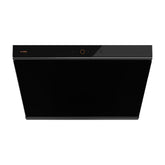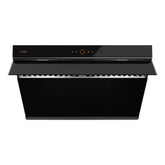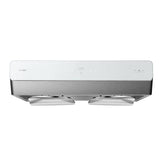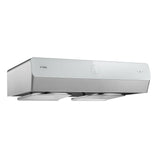What Size Wire For Electric Range? Wire Gauge Guide
Last Updated: 4/14/2025
Author: James Zhao, Sr. Tech Specialist & Alex Park, Product Specialist
Don't let the wrong wire size derail your kitchen upgrade. Knowing what size wire for an electric range can be the difference between a smooth installation and a hazardous fire risk.
In this guide, we’ll walk you through everything you need to know about wiring an electric range, including wire size requirements, cable types, outlet configurations, and safe installation practices. With guidance from FOTILE, you can avoid costly mistakes and keep your range running efficiently from day one.
If you’re ready to upgrade your kitchen with a smarter, cleaner appliance, FOTILE’s electric ranges reduce cooking fumes and create a safer, cleaner cooking environment. Browse our full collection of electric ranges and streamline your weekly cooking routines.
Wire Size Recommendations by Amperage
Choosing the right wire size for your electric range is the most important step in setting up a safe electrical connection. The appropriate wire gauge depends on the amperage your range draws, so always check your appliance's specifications before starting.
Use the following chart to identify the minimum American Wire Gauge (AWG) sizes based on amperage and conductor type. When in doubt, opt for a thicker wire or consult your local electrical code to ensure compliance:
| Amperage | Copper Wire Size (AWG) | Aluminum Wire Size (AWG) |
|---|---|---|
| 20 amps | 12 AWG | 10 AWG |
| 30 amps | 10 AWG | 8 AWG |
| 40 amps | 8 AWG | 6 AWG |
| 50 amps | 6 AWG | 4 AWG |
| 60 amps | 4 AWG | 2 AWG |
Choosing the Right Type of Cable
Once you know what size wire for your electric range, the next step is choosing the right type of cable. Some cables are better for dry, in-wall use, while others are built for exposed or moist environments.
- NM-B (Romex): The most common choice for electric ranges. Safe, easy to install, and ideal for dry, in-wall wiring.
- THHN/THWN in Conduit: Great for runs that require extra protection—especially in garages, basements, or exposed areas.
- MC Cable (Metal-Clad): Suitable for exposed runs if local code allows it. Provides strong protection against damage.
- Aluminum Cable: A lightweight alternative to copper, but requires upsizing the gauge. Always double-check compatibility and code requirements.
Wiring for 3-Prong vs. 4-Prong Receptacles
Understanding your receptacle configuration is just as important as knowing what size wire for an electric range. Older homes often use a 3-prong outlet, where the neutral and ground share a path. While this was once common practice, it poses a potential safety risk due to lack of separation between grounded and grounding conductors.
Modern standards now require a 4-prong outlet, which separates the ground and neutral wires— reducing the risk of electrical shock. If your existing outlet is 3-prong, you may need to upgrade it or wire your new range accordingly, depending on the local code and the model’s compatibility.
How to Wire an Electric Range (Step-by-Step Overview)
When wiring your electric range, follow these steps to safely connect your range to a 240-volt circuit:
- Turn off the power at the breaker. Always shut off power at the main panel before doing any electrical work.
- Choose the right power cord. Match your outlet type (3-prong or 4-prong) and check local code requirements.
- Remove the range’s access panel. This panel is usually located on the back of the appliance.
- Connect the wires to the terminal block. Match the cord wires to the terminals: two hot wires (usually red and black), one neutral (white), and one ground (green or bare copper). If using a 3-prong cord, the ground and neutral are bonded together.
- Secure the strain relief. This protects the wires from damage where the cord enters the range.
- Replace the access panel. Screw the panel back into place once all connections are tight and secure.
- Restore power and test. Flip the breaker back on and test the range to confirm it’s working properly.
Common Mistakes and How to Avoid Them
When wiring an electric range, avoid these common mistakes to keep your installation safe and up to code:
- Using the wrong wire size: Undersized wire can overheat and cause a fire. Always match your wire gauge to the amperage rating of your range.
- Mixing up neutral and ground wires: Confusing these wires can damage the appliance or create a shock risk. Double-check your wiring diagram and follow terminal labels closely.
- Skipping the strain relief clamp: Leaving this out puts stress on the internal connections. Always install a strain relief where the cord enters the range.
- Using outdated 3-prong outlets with 4-wire ranges: Plugging a new range into an old outlet without proper wiring changes violates code. Upgrade the outlet or wire your range correctly for a 3-prong setup if permitted.
- Failing to shut off the breaker before working: Working on a live circuit is extremely dangerous. Always turn off the power at the panel and test the outlet before starting.
When to Call a Licensed Electrician
If you’re uncertain about what size wire for your electric range, local electrical codes, or nervous about making the right connections, don’t take chances. A licensed electrician will ensure your range is wired safely, passes inspection, and performs at peak efficiency.
Upgrade Your Kitchen with a Premium FOTILE Electric Range
Once your wiring setup is ready, pair it with an electric range that’s as safe as it is stylish. FOTILE electric ranges feature built-in ventilation, advanced safety features, and efficient cooking technology—perfect for modern kitchens like yours.
Browse our full collection of electrician ranges – revolutionize your kitchen with a range that works smarter.
- Choosing a selection results in a full page refresh.






